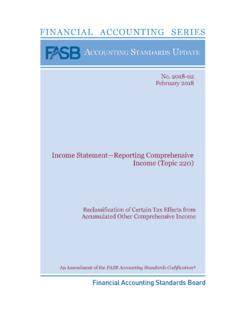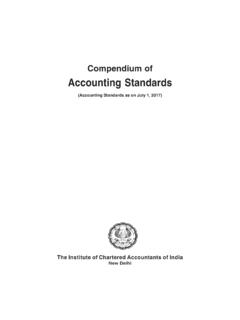Transcription of Covid-19 Impact on Financial Services Risk and Compliance
1 BEING RESILIENTCOVID-19 Impact ON Financial Services RISK AND COMPLIANCEBEING RESILIENT. THAT S LIVE is an unprecedented calamity on human beings, society and the world in general. This pandemic has already taken several hundred thousand lives and has impacted human health across the pandemic has also given a massive jolt to the global economy. Consumption is declining. Industrial production is nosediving. GDPs of all major nations are falling. Unemployment is increasing. Interest rates are falling. Development projects are getting deferred. Workforce productivity is dwindling. Stock markets are collapsing. Supply chains are getting shattered. Overall the global economy is staring at a big recession. This is the biggest challenge we are facing after the great depression of a key sector of the economy, banking and Financial Services industry has been affected tremendously. Organizations are struggling to keep vital Services up-and-running. Revenues are contracting. Cost reduction pressure is increasing.
2 New forms of Financial crimes such as fraud and cyber security are erupting. Liquidity risk is growing. Workforce productivity has reduced due to remote working. At the same time, new workload is getting added to manage relief package activities. On top of it, day by day regulators are providing new guidelines, and revised Compliance obligations are being enforced. These business challenges are having profound Impact on technology side too. This paper provides insights on the business and technology challenges faced by Financial institutions, and how the industry is coping with the pandemic and managing its risks. Firms risk management actions include both the short terms measures, as well as the development of strategic roadmaps to make their systems and processes resilient to such debilitating Document 2020 Infosys LimitedExternal Document 2020 Infosys LimitedKey Regulatory Changes Relaxed the implementation dates of new regulations Extended the submission deadlines for existing regulatory reports Suspended non-critical supervisory examination activities Allowed early adoption of risk/exposure calculation methodologies this would positively Impact liquidity Relaxed various buffers, and reserve ratio requirements c) may utilize alternative approaches (that are similar to the cumulative difference between provisions under ECL accounting model and that under prior incurred loss accounting model) d) for a 2 year period (2020 2021)
3 , may permit banks to add-back up till 100% of the transitional adjustment amount to CET1 Global Changes Governors & Heads of Supervision bodies have announced the delay of Basel III Implementation to enhance the operational capacity of supervisors and banks. Following are the changes in implementation timeline of outstanding Basel III standards :Given the disruptions that Covid-19 has caused, it s not a surprise that ensuring economic and operational resilience of the global Financial system has become the topmost concern of regulatory bodies across the globe today. For the past few months, governments and regulatory agencies have been pursuing a range of measures to alleviate the pandemic s Impact on world s Financial stability. Crucially, these measures have focused on ensuring continued lending by banks Basel Committee on Banking Supervision (BCBS) along with the International Organization of Securities Commissions (IOSCO) have decided to postpone the implementation of final two phases of margin requirements for the non-centrally cleared derivatives by 1 year BCBS has opted to postpone the implementation of revised G-SIB framework by 1 year BCBS has amended regulatory capital and on facilitating the banks ability to absorb losses in an orderly manner.
4 Understandably, the regulatory changes following the Covid-19 fallout are still dynamic in nature depending upon how the pandemic unfolds in the coming months, more changes are in are focused on implementing adequate measures to get Financial institutions back on the path of recovery. For example, they have:treatment of expected-credit-losses (ECLs). As per BCBS amendments and jurisdictions a) may apply current transitional arrangements, even in cases where these were not originally implemented (when banks had initially implemented the ECL model) b) may allow banks to change from the static approach to dynamic approach for determining transitional adjustment amount StandardOriginal date of implementationRevised date of implementation Revised leverage-ratio framework & G-SIB buffer Revised standardized approach for credit risk Revised Internal Ratings Based (IRB) approach for credit risk Revised operational risk framework Revised CVA framework Revised framework for the market risk Revised Pillar 3 disclosure framework1st Jan 20221st Jan 2023 Output floor1st Jan 2022; transitional arrangements to 1st Jan 20271st Jan 2023.
5 Transitional arrangements to 1st Jan 2028 External Document 2020 Infosys LimitedExternal Document 2020 Infosys LimitedCECL s Impact on regulatory capital Intraday credit: FRB has decided to defer by six months the implementation of changes to its Payment System Risk (PSR) Policy related to the provisioning of intraday credit to branches and the foreign banking organizations (FBOs) agencies Lending: FRB has made a technical alteration which allows banks to continue-lending to creditworthy households & businesses Regulatory reporting: US SEC has provided publicly traded firms with additional 45 days to file specific disclosuresFrance, Greece, Italy and Spain have all issued temporary short selling prohibitions in the wake of extreme volatility in trading Regulatory reporting: EBA has asked competent authorities for one-month flexibility in reporting dates of FIs Pillar 3 disclosures for the reports with dates of remittance between March & May 2020 2) limit certain insolvency & bankruptcy proceedings Capital & credit risk: The federal bank regulators have: 1) allowed early implementation of a new approach on how certain banks need to assess counterparty credit-risk derivatives contracts 2) provided optional-extension vis-a-vis the transition of regulatory capital for new credit loss accounting standard Also, Federal Reserve has taken steps to support credit flow to businesses and households.
6 These actions pertain to intraday credit, discount window, bank capital & liquidity buffers, and reserve Capital requirements: ECB has allowed banks to for the time being operate lower than the capital level defined by Pillar 2 Guidance (P2G), capital-conservation-buffer (CCB), and liquidity-coverage- ratio (LCR). The ECB has also recommended that national authorities slacken their required countercyclical-capital-buffers. Instruments that aren t considered as CET1 capital can be used In Australia, APRA, RBA and ABS have temporarily changed the reporting obligations of registered Financial corporations (RFCs) and authorized deposit taking institutions (ADIs) Counter party credit risk rule: The Fed, FDIC and OCC have permitted earlier adoption of standardized approach (SA-CRR) for calculating exposure amount of the derivative contracts under agencies regulatory capital rule. Furthermore, the SA-CCR have undergone many other modifications to the capital rule Current Expected Credit Loss (CECL) accounting Standard: The Fed, OCC and FDIC have issued interim-final-rule allowing banks to assuage the effects of CECL accounting standard on the regulatory capital.
7 Under this interim final rule, banks that implement CECL prior to 2020 end have the choice to defer for 2 years an estimate of the to certain extent for meeting the Pillar-2 Requirements (P2R) Stress testing: EBA has postponed its EU-wide stress-test until 2021. It has also advised that national regulators think of postponing non-essential supervisory activities & offer flexibility in banks regulatory reporting dates Trading: Regulators in Austria, Belgium, The Singapore government has launched the Covid-19 Act to 1) suspend particular contractual obligationsEuropeA PACE xternal Document 2020 Infosys LimitedExternal Document 2020 Infosys Limitedthe industry for a prolonged period. Refer below some of the key impacts of Covid-19 on the Financial Services industry, and the recommended actions for the Great Recession of 2008, banks and Financial institutions today are well-equipped owing to the various regulatory requirements. However high volatility in the markets, near-zero levels of interest rates, deteriorated credit quality, decline in collateral values, rapid liquidity shifts and tightening of liquidity, and deferred/delayed or cancelled payments would continue to pose significant challenges to Impact on Financial Risk Management FunctionsAreaKey ImpactsActions for Financial InstitutionsMarket & Liquidity Risk Increased volatility in markets cause high trading losses, affect earnings and capital preservations, generate big swings in the stress testing results, and lead to breaches limit/thresholds Impact on trading books Review the internal models for 1) value at risk2) asset liability management3) funding liquidity, market liquidity risk, probability of liquidity shortfall4)
8 Expected shortfall Review and monitor liquidity stress testing reports, and liquidity coverage ratio results Analyze the Impact of liquidity shortfall, and secured funding/asset sales Review capital allocations and hedging strategies Communicate beyond the LCR requirements to the regulators Contingency funding plan (CFP) Liquidity preservation actions should be part of the planCredit & Counterparty Risk Decline in credit quality and value of collateral; and Impact on valuations and funding costs Freeze on loan payments, minimal or delayed loan payments Current market & economic conditions would result in high probability of defaults leading to loan losses Change in overall creditworthiness of the counterparty Review the internal models for 1) probability of default, loss given default, exposure at default2) current expected credit loss3) risk rating and credit valuation adjustment Conduct additional stress testing on loan loss under new scenario specific to Covid-19 Frequently reassess counterparty s creditworthiness.
9 Diligently work with the intermediariesPortfolio & Financial Risk Higher volatility, price movements and counterparty risks to have direct Impact on risk-weighted assets Fee income, net interest income to be much lower due to less banking activities and interest rate cuts Review the internal models for 1) capital forecasting2) stress testing3) estimation of forward looking P&L, balance sheet, cash flows4) earnings/revenue loss Create new scenarios specific to the coronavirus Impact and conduct additional stress testing Review the valuations and pricing computation modelsExternal Document 2020 Infosys LimitedExternal Document 2020 Infosys LimitedTechnology Firms should strengthen their capabilities related to data assessment, news feeds analysis, preservation of electronic evidence, supply chain management, crisis management systems, and risk controls. This is crucial for:a) detecting discrepancies in Compliance systems that may Impact the firm s brand, reputation, and operational recovery b)
10 Ensuring sustained regulatory Compliance & reporting during the crisisEnabling secure and effective collaboration platform to address the work from home needs of employees is also Best Practices Review the data security, storage & retention plan to allow effective data retention, retrieval, and disposition Automate key process controls Automate regulatory requirement change management across geographies vis-a-vis policy definition, communication and storage Ensure timely communication and awareness of policy changes via conference calls, helplines, policy training modules, and accessibility of Compliance officers for responding to inquiries Institute standards and mandates for conducting business in unpredictable times by improving confidence, trust, and reputation Conduct audits to find and report defective controls or any alleged misconducts. This is important to ensure transparency while operating in times of crisis Periodically review and update the risk thresholds With regards to new regulatory changes, ensure effective organization change management such that it does not disrupt the operations of respective business functionsThe Covid-19 pandemic is disrupting the global Financial markets and is creating panic, uncertainty and distraction in the operations of global corporations.














